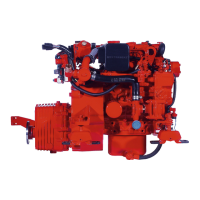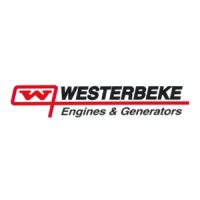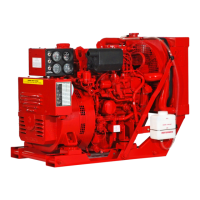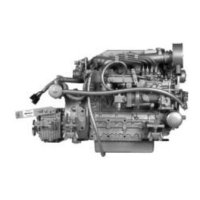SAFETY
INSTRUCTIONS
INTRODUCTION
Read
this
safety
manual
carefully.
Most
accidents
are
caused
by
failure
to
folww fundamental
rules
and
precautions.
Know
when
dangerous
conditions
exist and
take
the
necessary
precautions
to
protect
yourself,
your
personne~
and your
machinery.
The
follOWing
safety instructions
are
in
compliance
with
the
American
Boat
and
Yacht
Council
(ABYC)
standards.
PREVENT
ELECTRIC
SHOCK
A
WARNING:
Do
not
touch
AC
electrical
connections
while
engine
is
lunning,
01
when
connected
to
shore
powel.
Lethal
voltage
is
plesent
at
these
connections!
•
Do
not
operate
this
machinery
without
electrical
enclosures
and
covers
in place.
•
Shut
off electrical
power
before
accessing
electrical
equipment
•
Use
insulated
mats
whenever
working
on
electrical
equipment.
•
Make
sure your
clothing
and skin
are
dry,
not
damp
(particularly
shoes)
when
handling
electrical
equipment.
•
Remove
wristwatch
and all jewelry
when
working
on
electrical
equipment.
•
Do
not
connect ntility shore power
to
vessels
AC
circuits,
except
through
a ship-to-shore
double
throw
transfer
switch.
Damage to vessels
AC
generator
may
result
if
this
procedure
is
not
followed.
• Electrical shock
results
from handliog a cbarged
capacitor.
Discharge
capacitor
by
shorting
terminals
together.
PREVENT
BURNS
-
HOT
ENGINE
. A
WARNING:
Do
not
touch
hot
engine
parts
01
exhaust
system
components.
A
lunning
engine
gets
very
hot!
•
Always
check the
engine
coolant
level
at
the coolant
recovery
tank.
A
WARNING:
Steam
can
cause
injury
01
death!
•
In
case of
an
engine
overheat,
allow
the
engine
to
cool
before
touching
the
engine
or
checking
the coolant.
PREVENT
BURNS
-
FIRE
A
WARNING:
File
can
cause
injury
01
death!"
• Prevent
flash
fires.
Do
not
smoke
or
permit
flaines
or
sparks
to
occur near the
carburetor,
fuel line,
filter,
fuel
punlp,
or other
poten!ial
sources
of spilled fuel
or
fuel
vapors.
Use
a
suitable
container
to
catch all fuel when
removing
the
fuel
line,
carburetor,
or fuel
filters.
• Do
not
operate
without
a
Coast
Guard
Approved
flame
arrester.
Backfue
can
cause
severe
injury or death.
•
Do
not
operate
with
the
air
cleaner/silencer removed.
Backfire
can
cause sevete
injury
or
death.
•
Do
not
smoke
or
pennit
flames
or
sparks
to
occur near
the
fuel
system t(eep the compartment
and
the
engine/generator clean and
free
of debris to minimize the
chances
of
fire.
Wipe
up
all
spilled fuel
and
engine oil.
•
Be
aW\ll'e
- diesel
fueLw.jj]
burn.
PREVENT
BURNS
-
EXPLOSION
A
WARNING:
Explosions
flom
fuel
vapors
can
cause
in
jUlY
01
death!
•
Follow
re-fueling
safety
instructions.
Keep
the vessels
hatches
closed
when
fueling.
Open
and ventilate cabin
after
fueling.
Check below
for
fumes/vapor before
running
the
blower.
Run
the
blower for
four
minutes
before starting
your
engine.
•
All
fuel
vapors
are
highly
explosive.
Use
extreme
care
when
handling
and
storing
fuels.
Store
fuel
in a
well-ventilated
area
away
from
spark-producing
equipment
and out of
the
reach
of children.
•
Do
not
fill
the fuel
tank(s)
while
the engine
is
running.
•
Shut
off
the
fuel
service
valve
at
the
engine
when
servicing
the
fuel
system.
Take
care in catching
any
fuel
that might
spill.
DO
NOT
allow
any
smoking,
open
flames,
or other
sources
of
fire
near
the
fuel
system
or
engine
when
servicing.
Ensure proper ventilation
exists
when
servicing
the
fuel
system.
•
Do
not
alter
or
modify
the
fuel
system.
•
Be
sure
all
fuel supplieiiiave a
positivei~i\Utoff
valve.
•
Be
certall\
fuel line
fittings
are
adequately tightened
and
free ofleaks. .
•
Make
sure
a
fire
extinguisher is Installed
nearby
and
is
properly
maintained.
Be
familiar with
its
proper
use.
Extinguishers rated
ABC
by
the
NFPA
are
appropriate
for
all
applications encountered
in
this
environment.
~
WESTERBEKE
Engines & Generators
•
I

